Types of Whitewater Rafts
There are three main types of rafts: paddle boats, gear boats and oar/paddle combination rafts. Each craft has its specific uses. Paddle boats can carry the most people, require the least amount of rigging. Gear boats are best for transporting lots of equipment on multi-day trips. Oar/paddle combos and stern mounts can carry more people than a gear boat with greater acceleration while allowing a guide more control than with a paddle boat. All three types of whitewater boats have their advantages. This post will also look at other whitewater crafts including motor rafts, dories, inflatable kayaks, packrafts, catarafts, and hardshell kayaks. We also have a post on the different whitewater raft designs and materials.
1. Paddle Boats
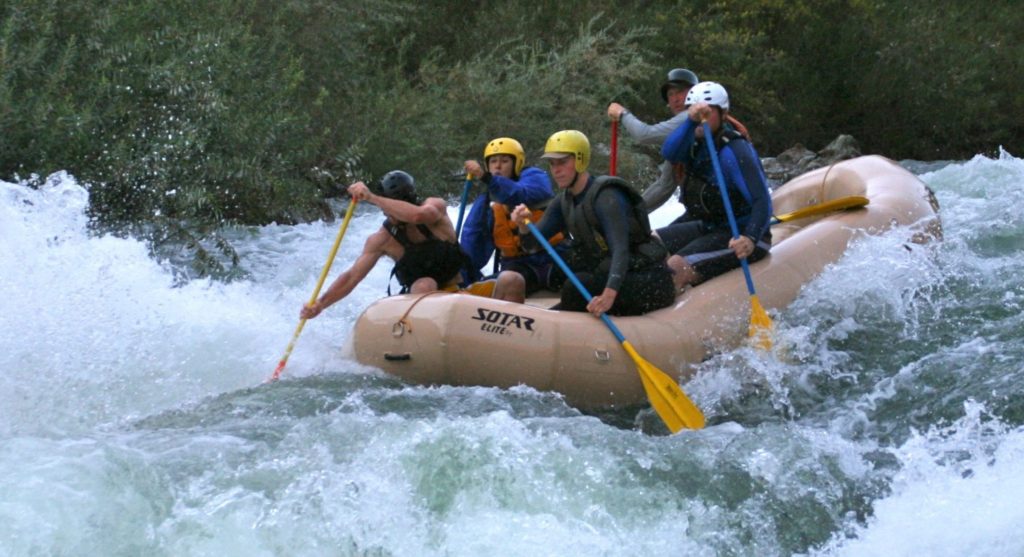
The most popular inflatable raft for whitewater is a paddle boat. In a paddle raft everyone has a paddle with a guide in the back giving commands and steering. The most common paddle boat is a 14-foot raft with six paddlers and a guide. This type of raft is ideal for day trips on class III and IV water. The best paddle rafts are stiff so they don’t fold making it easy for people to hold their positions in the raft.
Historically paddle boats had two thwarts. However, the newer rafts with three thwarts making it easier for all 6 paddlers. The most dangerous place to sit in a paddle raft is the back which acts like a launching pad when rafts go over bigger drops. Many guides prefer oar rafts or oar/paddle combo rafts for the added control of not needing to rely on paddlers. Running a paddle raft well requires training your paddle crew.
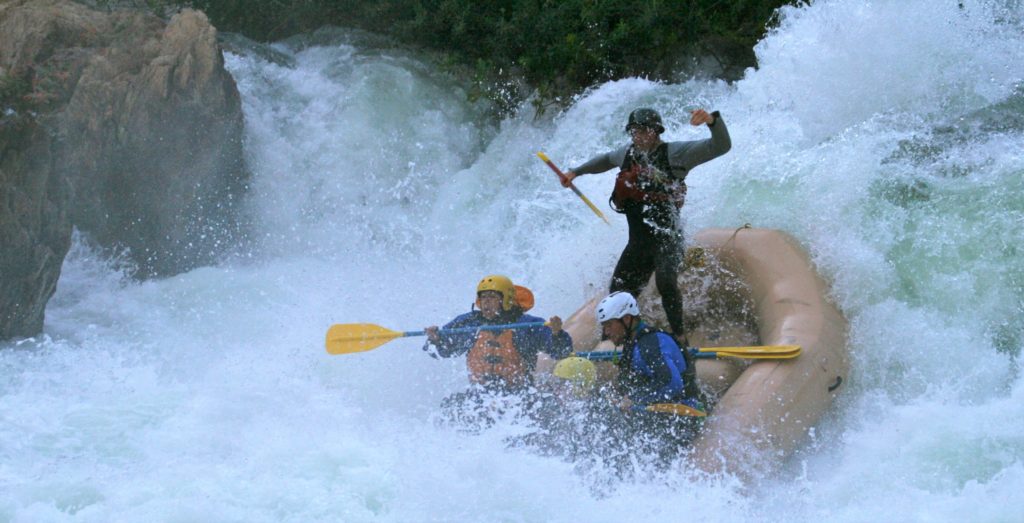
2. R-2 (raft- 2 people)
R-2ing has increased in popularity over the years. R-2 stands for raft with two people. Most often the two paddlers will sit across from each other in the middle of the raft. Paddlers typically discuss where they want to take the raft rather than calling out commands. Since there is less weight in the boat it more maneuverable and less likely to flip off of rocks. Many of the people running hard technical class V rivers prefer R-2ing.
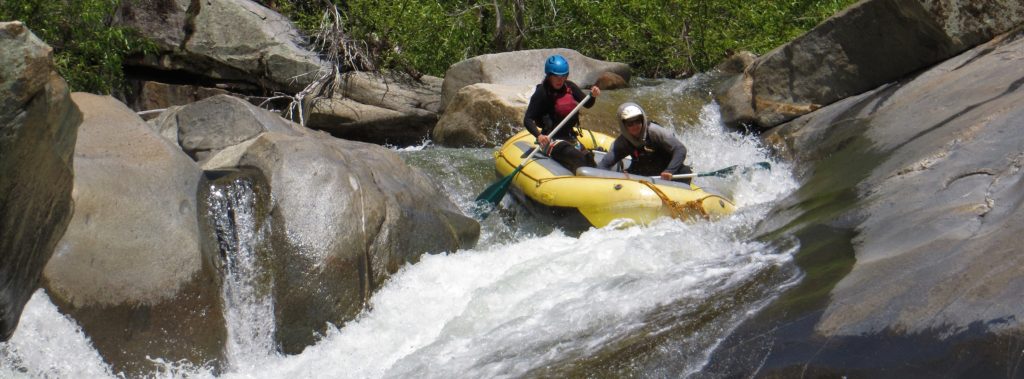
While R-2ing is attractive because of the ease of running rivers, it is also popular due to the ease of organizing and getting on the river. All one needs is a buddy and minimal rafting gear. Rigging at put-in is fast and gear doesn’t take much room in the car. This my favorite way to run a river.
3. Oar/paddle Combos (Stern Mounts)
As rivers increase in difficulty it’s helpful for the guide to have added control when steering the raft. This is more true on high-volume rivers where rafts need to be turned to face into large breaking diagonal waves. An oar/paddle combo raft takes the best of aspects rowing, the ability to easily turn the raft and combines it with the power and acceleration of a paddle boat. The biggest disadvantage is the oars can quickly become dangerous weapons when surfing in a hole or if they get caught on a rock. On rocky rivers guides have to ship their oars constantly making a paddle raft more functional in those moments.
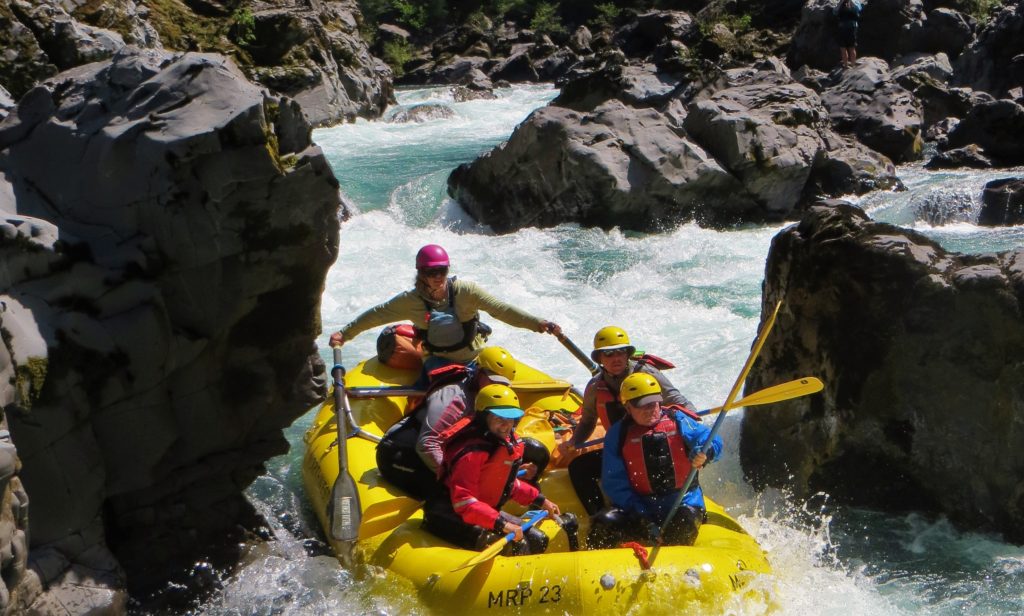
Sometimes oar/paddle combos are referred to as stern mounts. In this case the small frame is rigged on the stern of the raft. This works well on high water as it allows for a maximum number of paddlers to still ride in the raft. However, much like a paddle raft when going over drops this rig is known to launch guides causing injuries.

A creek frame (or day frame) is a small frame that is rigged on the flat part of the raft in front of the stern. This puts the guide in a more stable position so they are less likely to get thrown around. The disadvantage of this rig is that there is less space for paddlers. A 14-foot raft would have space for a maximum of 4 paddlers plus a guide. While a stern mount in a 14-foot raft would have space for 4 paddlers.
4. Gear Boat
In a gear boat the guide is most often seated on a cooler close to the center of the raft surrounded by a frame that can carry an extensive amount of gear. There is typically space for two to three people to sit in the front of the raft. Lounging in the front of a gear boat float through a canyon is one of the most enjoyable ways to travel.
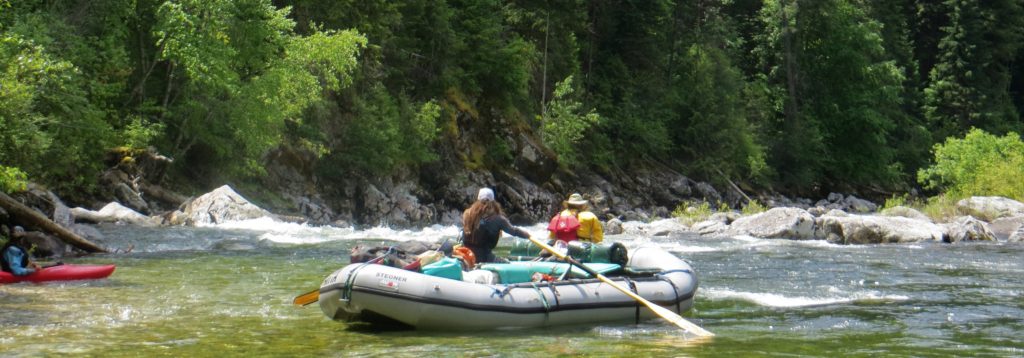
Some gear boats will have the back of the raft completely full with gear. Others will have two more people sitting in the back of the boat. This can also be fun and a little more dangerous. The passengers in the back of the boat need to be watched because if they sit up high it is easy for them to get thrown. In addition, on rocky rivers when shipping oars guides have to be careful that if their oar catches a rock it doesn’t shoot back and hit the rider behind them.
5. Oar Boat
An oar boat is a type of gear boat without the gear. Instead it has a light center mount frame (though many times it is a little aft of center). Like an oar/paddle combo, the seat for an oar boat is usually a tractor seat or a slant board. An oar boat is usually light with just the rower and maybe a little bit of gear just for a day. These boats are nimble and great for rocky low volume runs. They are terrible in big water when they get knocked around by waves due to their lack of mass.
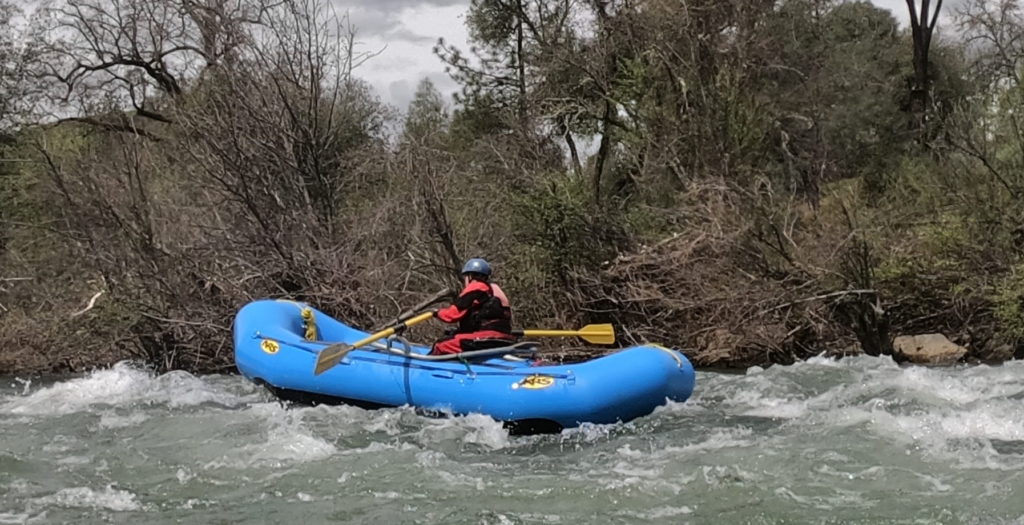
Other Types of Whitewater Craft
Inflatable rafts are the standard whitewater craft for commercial whitewater trips. However, plenty of other types of boats are used in whitewater. The most common are catarafts, motor rafts, dories, inflatable kayaks, and kayaks.
6. Catarafts
Catarafts are similar in use to rafts but have a few key differences due there being no inflated floor. Also called Cat Boats and Cats, catarafts can perform like sports cars or an unwieldy tanker depending upon how much weight is in it. The two tubes in the water create minimal drag but this also means less area for displacing weight.
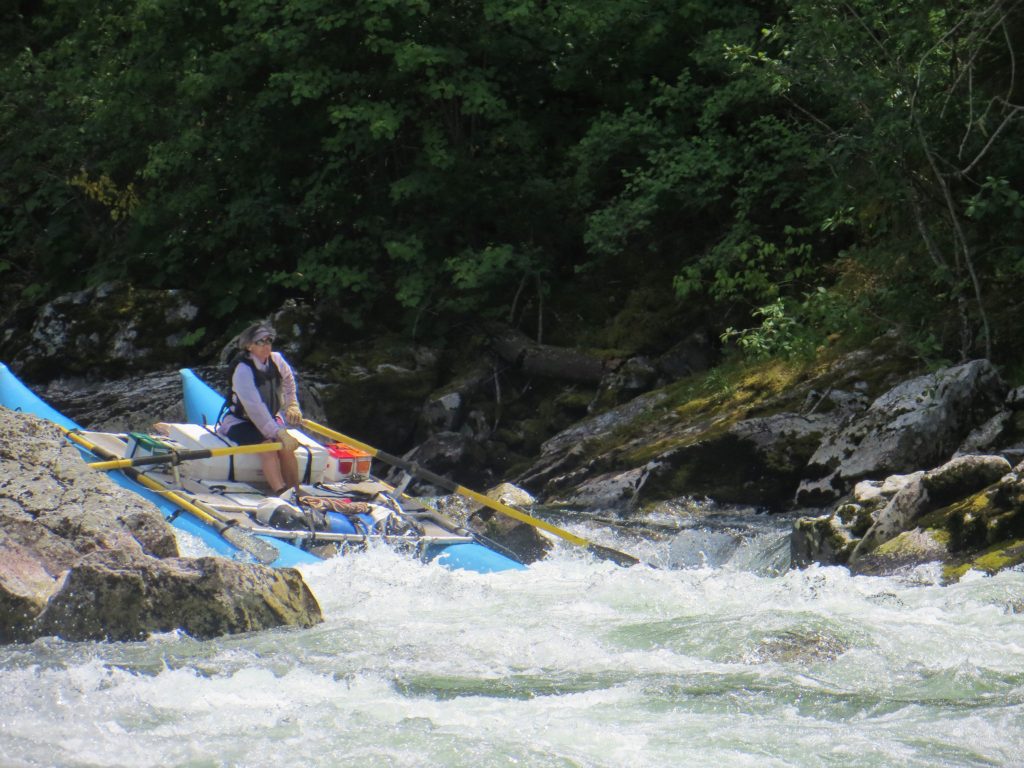
Light catarafts turn (particularly shorter ones with rocker) and accelerate quickly. Due to the minimal contact with the river it is much easier to punch through holes in a Cat Boat and they are more challenging to flip in hole due to the lack of a floor. However, light Cats flip easily when pushed up against a rock sideways.
Their are some disadvantages with catarafts. The lack of the inflated floor makes it challenging to take more than the rower and they are not comfortable for passengers. Unfortunately, heavier loads quickly push catarafts deep into the water. They draft so much water that they are incredibly stable but equally difficult to turn.
Safety Catarafts
One of the best uses of the cataraft is for downstream safety on high water rafting trips. Since the first boat is most exposed its ideal to have a minimum number of people in the boat in case it flips. It is also nice to have a craft that is extremely manuverable, stable and can carry 4 or 5 people for a short period of time and still help get another raft to shore. The safety cataraft can do all these things.
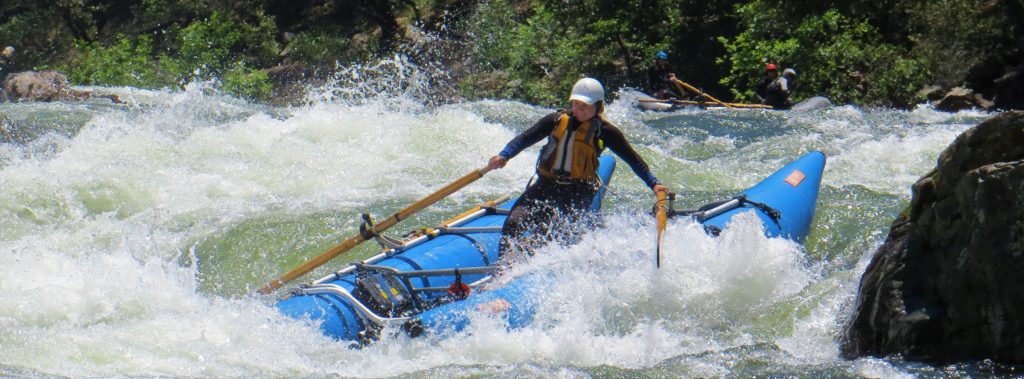
Overall, catarafts are a cheaper way to get on the river if you are looking to be by yourself in a boat. they are also lighter and easier to get to and from the river. Get the right amount of weight and they perform like a dream and are typically more forgiving than rafts.
7. Motor Rafts
These boats predominantly used on the Colorado River in the Grand Canyon. Due to high flow and the minimal number of rocks, these large inflatable rafts are able to negotiate the rapids use a small outboard motor. These boats are typically over 30 feet long and can carry almost 20 people.
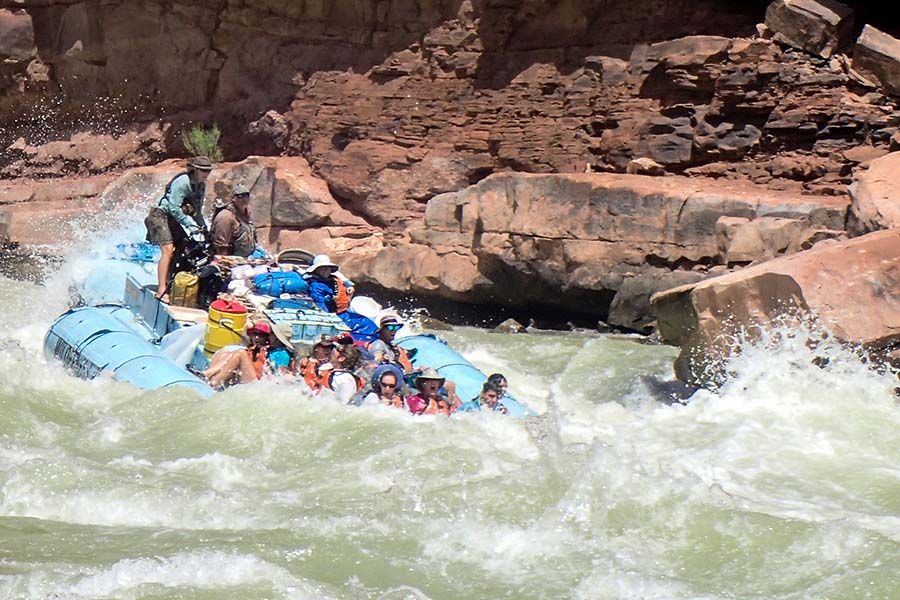
8. Dories
The original commercial rafting trips were on dories and motor rigs. While the huge motor rigs go for the biggest waves on the river. The dories are the darting sports cars slicing between river features that could easily flip them.
Dories historically were made of wood. Guides have to be ever vigilant since what would be a bump of a rock with a raft can cause serious damage to a dory. Some dories are now made with aluminum to be a little more durable but more difficult to repair.
Dories sit on top of the water rocking back-and-forth and side-to-side going down the river. Unlike ocean going dories, whitewater dories have rocker (rise in the bow and stern) to make turning the boats easier. They are the most exciting ride of the larger river crafts.
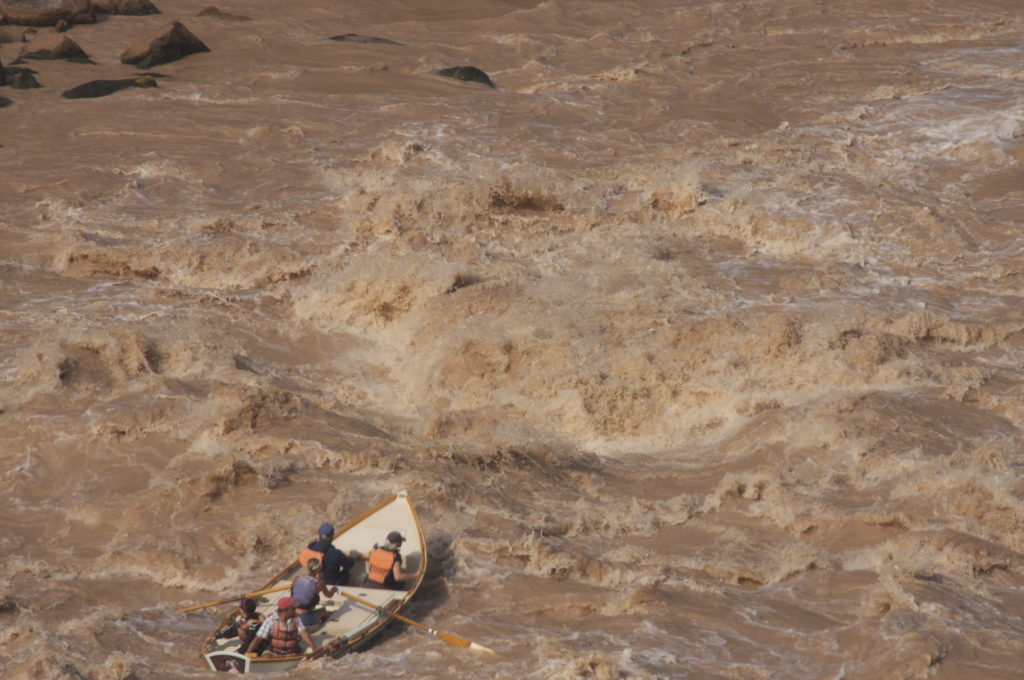
Types of Kayaks
9. Inflatable Kayaks
Inflatable kayaks (aka: Duckies) are pretty much miniature rafts designed for one to two people using kayak paddles. Duckies are smaller and sit lower to the water giving a more exciting ride. The inflated tubes make them fairly stable but they still flip easily in larger hydraulics.
10. Packrafts
Packrafts are basically extra light inflatable kayaks designed to be easy to carry into remote water ways. Like inflatable kayaks they can be fairly high performance. A fairly common upgrade on packrafts is to have a stow zipper on the boat which allows gear to be stored within the tubes. This improves performance by giving the raft a lower center of gravity and allows for significant carrying capacity.
11. Hardshell Kayaks
Generally referred to as kayaks. Hardshell kayaks are mainly made out of plastic and sometimes fiberglass. They are much more challenging to learn to use but they are also much more high performance much like the relationship between dories and rafts.
Whitewater kayaks typically have a skirt unlike inflatable kayaks so that they stay more maneuverable by not taking on water.